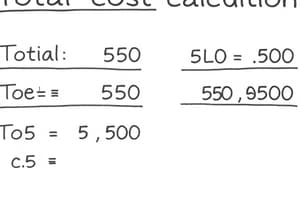Podcast
Questions and Answers
What is the selling price if you purchase an item for $70 and want to make a 30% profit?
What is the selling price if you purchase an item for $70 and want to make a 30% profit?
$91
How do you calculate profit?
How do you calculate profit?
Profit = Sales Price - Cost Price
Define profit and loss in terms of revenue and expenses.
Define profit and loss in terms of revenue and expenses.
Profit: Revenue > Expenses; Loss: Expenses > Revenue
If you sell an item for $120 that you bought for $100, what is your profit?
If you sell an item for $120 that you bought for $100, what is your profit?
What is the formula to calculate Profit/Loss?
What is the formula to calculate Profit/Loss?
What happens when revenue equals expenses?
What happens when revenue equals expenses?
If you made $90 from selling an item and spent $80 on costs, what would be your profit?
If you made $90 from selling an item and spent $80 on costs, what would be your profit?
How do you calculate loss?
How do you calculate loss?
If your total expenses were $95 and you made $90 from selling an item, what would be your financial outcome?
If your total expenses were $95 and you made $90 from selling an item, what would be your financial outcome?
How is calculating loss different from calculating profit?
How is calculating loss different from calculating profit?
If you sold an item for $60 and bought it for $80, what would be your loss?
If you sold an item for $60 and bought it for $80, what would be your loss?
What do negative signs indicate in profit and loss calculations?
What do negative signs indicate in profit and loss calculations?
Flashcards are hidden until you start studying
Study Notes
Math Word Problem
A math word problem is a type of mathematical question where a specific situation is described and requires numerical analysis. These types of problems require you to apply various mathematical concepts such as arithmetic, algebra, geometry, and statistics to find the solution. Word problems often deal with real-world scenarios like buying and selling goods, comparing prices, calculating profits, and determining losses. In this article, we will explore these subtopics related to word problems.
Selling Items
Selling items involves determining how much to charge customers based on the cost price and desired profit margin. For example, if you purchase an item for $50 and want to make a 20% profit, your selling price would be $50 * 1.2 = $60. This allows you to sell the item while covering costs and making a profit.
Calculating Profit
Profit is the difference between what you earn from selling something and what it cost you to acquire or produce it. It can be calculated using the following formula: Profit = Sales Price - Cost Price. For instance, if you sold an item for $80 and bought it for $60, your profit would be $20 ($80 - $60).
Profit and Loss
The concept of profit and loss relates directly to the difference between your revenue and your expenses. If your revenue exceeds your expenses, you have made a profit; if they equal each other, you have broken even; and if your expenses exceed your revenue, you have experienced a loss. This can be illustrated using the following formula: Profit/Loss = Total Revenue - Total Expenses. For example, if you made $90 from selling an item and spent $80 on costs related to that sale, your profit would be $10 ($90 - $80). However, if your total expenses were $95, you would experience a loss of $5 ($90 - $95).
Calculating Loss
Calculating loss is similar to calculating profit but with a negative sign. Loss = Sales Price - Cost Price. If you sold an item for $60 and bought it for $80, your loss would be -$20 ($80 - $60). Negative signs indicate losses.
In conclusion, math word problems are practical scenarios where mathematical concepts like arithmetic, algebra, geometry, and statistics come together. They offer real-world applications of these concepts and often involve topics such as selling items, calculating profits, determining profit and loss, and assessing losses. By understanding and applying these subtopics, we can better analyze and solve word problems and make informed decisions based on numerical information.
Studying That Suits You
Use AI to generate personalized quizzes and flashcards to suit your learning preferences.




